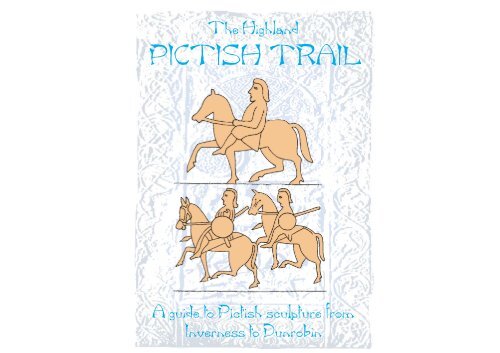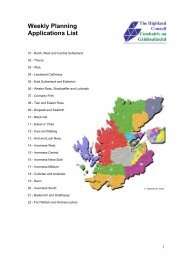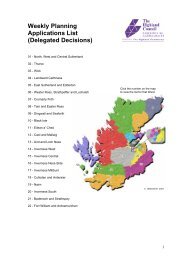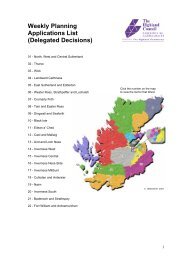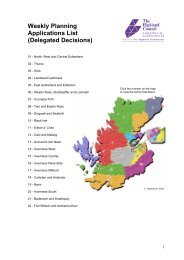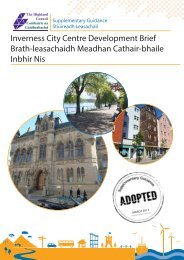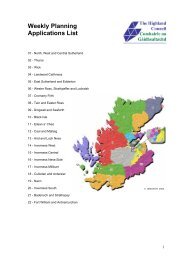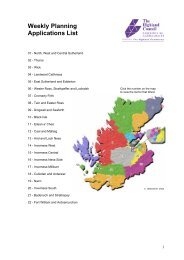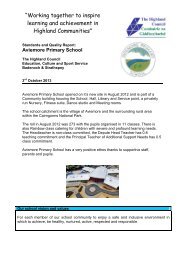PICTISH TRAIL - The Highland Council
PICTISH TRAIL - The Highland Council
PICTISH TRAIL - The Highland Council
Create successful ePaper yourself
Turn your PDF publications into a flip-book with our unique Google optimized e-Paper software.
<strong>The</strong> <strong>Highland</strong><br />
<strong>PICTISH</strong> <strong>TRAIL</strong><br />
A guide to Pictish sculpture from<br />
Inverness to Dunrobin
Pictish Trail Guide<br />
“Mysterious and often beautiful, Pictish sculpture presents<br />
one of the great puzzles of Dark Age archaeology”<br />
(Joanna Close-Brooks 1989)<br />
<strong>The</strong> Route<br />
KEY<br />
Town or Village<br />
Pictish Stone Site<br />
Recommended Pictish Trail Route<br />
Alternative Route Links<br />
A9 Trunk Road<br />
Arabella Roundabout<br />
Leaving Inverness, follow the A9 northwards over the<br />
Kessock Bridge to the Black Isle.<br />
Follow signs for Groam House Museum, Rosemarkie.<br />
From here you can either continue across the Cromarty -<br />
Nigg car ferry (seasonal - to check timetable contact local<br />
tourist offices) or follow the coast road around the Black<br />
Isle to Dingwall and Strathpeffer.<br />
Sites 8 - 13 are signposted from the A9 at the Arabella<br />
roundabout ( on the map).<br />
All the sites have free parking available nearby unless<br />
otherwise indicated. Please contact <strong>The</strong> <strong>Highland</strong> <strong>Council</strong><br />
Public Transport section (Tel: 01463 702695) for details of<br />
public transport services in the area.<br />
Pictish Trail<br />
17<br />
N<br />
EAGLE<br />
STONE<br />
5<br />
STRATHPEFFER<br />
0 5 10 15 20km<br />
Based upon <strong>The</strong> Ordnance Survey mapping © Crown copyright.<br />
<strong>The</strong> <strong>Highland</strong> <strong>Council</strong> LA09036L.<br />
Planning & Development Service. Feb 2002 (hqpldm)<br />
A834<br />
ARDGAY<br />
KINCARDINE OLD CHURCH<br />
DINGWALL<br />
MUIR OF ORD<br />
BEAULY<br />
DINGWALL<br />
CHURCHYARD<br />
4<br />
A862<br />
A835<br />
A9<br />
15<br />
A9<br />
B9176<br />
Cromarty Firth<br />
A832<br />
Beauly Firth<br />
B9161<br />
1 KNOCKNAGAEL<br />
BOARSTONE<br />
2 INVERNESS<br />
MUSEUM<br />
BONAR BRIDGE<br />
ST DEMHAN’S<br />
CROSS<br />
ARDROSS<br />
16<br />
B9176<br />
A9<br />
B9163<br />
A832<br />
EDDERTON<br />
CHURCH<br />
YARD<br />
ROSSKEEN<br />
THIEF’S STONE<br />
A9<br />
A9<br />
B817<br />
INVERGORDON<br />
GROAM<br />
HOUSE<br />
MUSEUM<br />
A949<br />
A836<br />
CLACH 14<br />
BIORACH 13<br />
6<br />
1<br />
2<br />
7<br />
Moray Firth<br />
A832<br />
A9<br />
A9<br />
TAIN<br />
A9<br />
A9<br />
ROSEMARKIE<br />
INVERNESS<br />
TAIN<br />
MUSEUM<br />
3<br />
DUNROBIN<br />
CASTLE<br />
MUSEUM<br />
17<br />
Dornoch Firth<br />
12<br />
A9<br />
8<br />
B9175<br />
GOLSPIE<br />
DORNOCH<br />
B9174<br />
NIGG OLD<br />
CHURCH<br />
CROMARTY<br />
A9<br />
Dunrobin Castle<br />
B9165<br />
Ferry (2 car - summer only)<br />
9<br />
BALINTORE<br />
NAIRN<br />
BRORA<br />
Moray Firth<br />
TARBAT<br />
DISCOVERY<br />
CENTRE<br />
PORTMAHOMACK<br />
11<br />
10 HILTON OF CADBOLL<br />
SHANDWICK<br />
SCOTLAND
Who were the Picts?<br />
<strong>The</strong> Picts lived in north and east Scotland in the 3rd to 9th centuries AD. We know little<br />
of their history as very few written records survive, and none in the Pictish language.<br />
<strong>The</strong>re are a few inscriptions however which suggest that they spoke a language closely<br />
related to both Welsh and Gaelic. <strong>The</strong> name first appears in Roman sources as Picti,<br />
meaning ‘the decorated or painted people’ - perhaps a reference to tattooing or war<br />
paint. However this may be the latinised form of an older name. In Gaelic the Picts are<br />
called Cruithne - the Welsh form of which has given us ‘Briton’ and ‘Britain’. <strong>The</strong>y<br />
intermarried with the Irish Scotti and jointly raided Roman Britain. <strong>The</strong>re were also<br />
extensive contacts with Anglo-Saxon Northumbria. Both these interactions can be<br />
seen in the art of the later carved stones. From the 9th century, Picts and Scots were<br />
both ruled by a single king - although by then, Shetland, Orkney, Caithness,<br />
Sutherland, and the Hebrides were all under Norwegian control.<br />
Symbols and Designs<br />
<strong>The</strong> famous symbols are unique to the Picts. <strong>The</strong>ir purpose and meaning are still<br />
unknown, but they appear over a long period on jewellery, and as graffitti, as well as on<br />
carved stones. <strong>The</strong>y frequently appear in pairs, and have been interpreted as indicating<br />
particular kindreds, lineages or clans, or as a pictographic system of writing. However<br />
they may have mythological or religious meanings - there are many examples of early<br />
medieval carved stones from England, Ireland, the Isle of Man and Scandinavia where<br />
pagan and Christian themes are combined. Like these stones too, they probably<br />
commemorate individuals. In a few cases associated graves have been found.<br />
Below are examples of Pictish designs and symbols which can be seen on the Trail.<br />
Also look out for cup-marks, which appear on some of the stones. <strong>The</strong>se are circular<br />
hollows created in patterns on the face of a stone, and are generally thought to be prehistoric<br />
in date.<br />
Classification<br />
<strong>The</strong> Pictish stones have been conventionally divided into three groups:<br />
Class 1 : unworked stones or boulders, with symbols only incised on them, dating<br />
from the 6 th , 7 th and 8 th centuries.<br />
Class 2 : major works of art, dating from the 8 th and 9 th centuries. <strong>The</strong>y are quarried<br />
and cut rectangular slabs, usually of sandstone, which are finely carved in relief with<br />
Pictish symbols mingled with Christian motifs. On one side there is often a large<br />
cross, with its surface and surrounding spaces filled with elaborate designs. <strong>The</strong><br />
surface style of the decoration is generally similar to manuscript illumination and<br />
religious metalwork of the period.<br />
Class 3 : this is a catch-all for any Pictish sculpture from the 8 th or 9 th century, where<br />
no symbol has been identified. It includes fine cross-slabs, recumbent gravemarkers,<br />
free-standing crosses and composite stone shrines.<br />
Pictish symbols:<br />
Crescent Crescent & V-rod Double disc Double disc & Z-rod<br />
Horseshoe Mirror case Mirror & comb Pictish beast<br />
Step Tuning fork Inverted L<br />
Naturalistic symbols:<br />
Fish Boar Eagle Wolf<br />
Designs include:<br />
Key-pattern (e.g. Rosemarkie) Knotwork (e.g. Nigg) Spirals (e.g. Nigg)<br />
Not all stones fit into this classification. At Creich, for example, there is a cross<br />
incised on a rough standing stone (no.16).
1. Inverness - the Knocknagael Boar Stone<br />
This Class 1 stone previously stood at<br />
Knocknagael, on the south side of Inverness<br />
beside the road to Essich (NH 656 413). It<br />
is a large, rough slab with the incised figure<br />
of a boar, and above it a mirror case symbol.<br />
In 1991 it was moved for its protection to <strong>The</strong><br />
<strong>Highland</strong> <strong>Council</strong>’s HQ in Glenurquhart Road,<br />
where it can be seen through a large window.<br />
Visible through window all year, entry to<br />
building by appointment. Car parking<br />
usually available at rear of building.<br />
Contact: HC Archaeology Unit 01463 702250.<br />
2. Inverness Museum (collection)<br />
Eight Class 1 stones are on display, including the Ardross Wolf (see no.6 below) and a<br />
fragment from Little Ferry Links (Sutherland) that matches a piece in Dunrobin Castle<br />
Museum (see no.17). A catalogue is available for sale in the shop (see reading list).<br />
<strong>The</strong>re are also examples of Pictish metalwork showing the symbols.<br />
In Castle Wynd. Open all year (free). Contact: 01463 237114.<br />
3. Rosemarkie - Groam House Museum (collection)<br />
Rosemarkie was the site of an early Christian centre in<br />
the 8 th and 9 th centuries AD. Today, you can examine the<br />
surviving fragments of Pictish sculpture gathered together<br />
in the museum display. <strong>The</strong> centrepiece of the permanent<br />
exhibition is a magnificent Class 2 cross-slab, covered<br />
with elaborate and intricate designs reminiscent of Pictish<br />
metalwork. <strong>The</strong>se include two crosses as well as three<br />
crescent and V-rod symbols, one double-disc and Z-rod, a<br />
comb, mirror, and mirror-case. <strong>The</strong> museum also houses<br />
a comprehensive collection of photographs of the Pictish<br />
stones of Scotland.<br />
Open 1 May to 30 September 10am to 5pm (Mon-Sat)<br />
2-4.30pm (Sun); 1 Oct to 30 April 2-4pm (Sat and<br />
Sun). Contact: 01381 620961 . Disabled access to<br />
ground floor only.<br />
4. Dingwall - the Churchyard Stone<br />
This Class 1 stone was found in 1880, re-used as a lintel in the<br />
church. It was taken out and set up in the churchyard facing the<br />
entrance gate. On the front are a double disc and Z-rod, and two<br />
crescent and V-rods, and on the back three circles and a crescent<br />
and V-rod as well as six cup marks.<br />
Accessible all year.<br />
5. Strathpeffer - the Eagle Stone<br />
This Class 1 stone stands on a small, probably artificial mound.<br />
On one face is a decorated horseshoe symbol above an eagle.<br />
Its Gaelic name (Clach an Tiompain) means ‘the Sounding Stone’.<br />
Accessible all year. Signposted from the road along a short<br />
footpath.<br />
6. Ardross Stones<br />
Two Class 1 sandstone fragments, bearing incised representations of a deer and wolf in<br />
Pictish style, were found ‘built into an old wall at Stittenham’ before 1891. Often known<br />
as the Ardross Wolf and Deer (or Horse), they are preserved in Inverness Museum<br />
(no.2). Copies have been carved and set up outside the new Ardross Hall.<br />
Accessible all year. Park in the car park and walk round the side of the building.
7. Rosskeen - the Thief’s Stone<br />
<strong>The</strong> Clach a’Mheirlich or ‘Thief’s Stone’ (Class 1) stands in a field by<br />
the Alness to Invergordon road. On the front is an incised step<br />
symbol and on the left side what appear to be the traces of a<br />
crescent symbol with a pair of pincers below.<br />
Park in the ‘Public slipway’ car park.<br />
<strong>The</strong> stone is about 20m into the field across the road.<br />
Visible all year, but please view from roadside - do not climb over the fence.<br />
8. Nigg - the Nigg Stone<br />
This magnificent Class 2 cross-slab now stands inside the church.<br />
<strong>The</strong> decoration has similarities with the 8 th -century free-standing<br />
crosses on Iona, the St Andrews Sarcophagus (a Pictish royal shrine)<br />
and the illuminated gospel-book, of the same date, known as the<br />
Book of Kells. <strong>The</strong> great cross is set against a background of<br />
bosses made up of snakes, and the pediment above illustrates an<br />
episode in the life of St Paul the Hermit as told by St Jerome. On the<br />
reverse there is an eagle symbol, hunting scenes, and an illustration<br />
of the Biblical story of how David killed a lion in order to save a lamb<br />
in his flock. A detached fragment, including part of a Pictish beast<br />
symbol was found in 1998. It is currently in Tain Museum (No.12).<br />
<strong>The</strong> church is open 1 April to 31 October, 10am-5pm.<br />
Contact: Nigg Old Trust 01862 832214.<br />
9. Shandwick - the Shandwick Stone<br />
This impressive Class 2 cross-slab was a landmark for local boats.<br />
It is now protected by a glass shelter. Facing the sea, its great<br />
cross is covered with bosses and interlocking spirals. On the back<br />
are five panels of decoration. At the top is a double-disc symbol<br />
above a Pictish beast, while another shows a hunting scene, fighting<br />
swordsmen and a hunter with a cross-bow. <strong>The</strong> complex patterns of<br />
serpents biting their own bodies have parallels in 8 th -century<br />
metalwork from Britain, Ireland, and continental Europe. Its Gaelic<br />
name (Clach a’ Charaidh) means ‘stone of the grave-plots’. A burial<br />
ground here was recorded in 1889 as last used during the cholera<br />
epidemic of 1832 and ploughed under about 1885.<br />
Visible through glass all year, entry to shelter by appointment. Park in the lay by provided<br />
and cross the stile (no wheelchair access). Contact: Shandwick Stone Trust 01862 832525<br />
or 07831 894450<br />
10. Hilton of Cadboll<br />
<strong>The</strong> Hilton of Cadboll cross-slab (Class 2) once stood<br />
outside St Mary’s chapel at Cadboll, the remains of<br />
which can still be seen as grass covered mounds. In<br />
1676 the face bearing the cross was defaced and an<br />
inscription cut to commemorate Alexander Duff and his<br />
three wives. In the 19 th century the stone was removed<br />
to Invergordon castle, and in 1921 it was presented to<br />
the British Museum in London. However the following<br />
year it was returned to Scotland and it is now in the<br />
Museum of Scotland in Edinburgh. In 2000, a new<br />
stone was set up at the chapel site, which was carved<br />
to reproduce as closely as possible the design of the<br />
surviving face of the original.<br />
<strong>The</strong> main panel depicts a woman mounted on horseback,<br />
accompanied by other mounted figures, musicians and animals in a detailed<br />
hunting scene. A mirror and comb symbol is to her left. Above are a crescent and Vrod<br />
and at the top, a double disc and Z-rod.<br />
Accessible all year. Park in the lay by and follow the path to the site, which is in the care<br />
of Historic Scotland. Note: there are no laid paths within the site itself.<br />
11. Portmahomack - Tarbat Discovery Centre (collection)<br />
Housed in the refurbished interior of Tarbat Old<br />
Parish Church, the Centre displays fragments of<br />
Pictish sculpture revealed by ongoing<br />
excavations at the site. <strong>The</strong>y include cattle<br />
licking their new-born calf, a rooting wild boar,<br />
and a snarling dragon with a serpent head on its<br />
tail. <strong>The</strong>re are also replicas and photographs of<br />
the pieces of Pictish sculpture from Tarbat which<br />
are now in the Museum of Scotland in Edinburgh.<br />
<strong>The</strong> excavations by the University of York have<br />
revealed an 8 th -century Pictish monastery, its stone buildings, farm, and metalworking<br />
shop. <strong>The</strong> Centre has interactive touchscreens with information on the Picts, and<br />
shows a video on the Picts of Easter Ross. When the dig is in progress, tours guided<br />
by archaeologists are included in the admission charge to the Centre.<br />
Open: 1st Sat. in March to 1st Sat in May 2-5pm; 1st Sun in May to last Sat in Sept<br />
10am-5pm; last Sunday in Sept to 23 December 2-5pm. Closed January & February.<br />
Contact: Tarbat Discovery Centre 01862 871351.
12. Tain and District Museum (collection)<br />
Outside the museum door, in the churchyard, is the Ardjachie Stone (Class 1), found at<br />
Meikle Ferry (NH 746 845) in 1960. One face has about 30 irregular cup-marks and<br />
two unusual symbols - a spoked wheel and an inverted L.<br />
Visible all year - it is just inside the churchyard gate to Castle Brae, outside the museum<br />
doorway.<br />
In the museum itself are fragments of two Pictish stones found at Edderton Churchyard<br />
(No.13) in 1992, and also a fragment of the Nigg stone (No.8) found in 1999.<br />
Limited parking is available in Castle Brae - otherwise park by the Royal Hotel and<br />
walk down. Wheelchair access via Tower Street entrance.<br />
Museum open March to October 10 am-6 pm, or at other times by appointment.<br />
Contact: Tain Through Time 01862 894089.<br />
13. Edderton - Churchyard<br />
A Class 3 cross-slab, now leaning, in the churchyard of the former<br />
parish church. On the west face is a Celtic cross, with a broad circle<br />
around the intersection; on the east face a Latin cross (upright, with<br />
the lower limb longest) and a horseman in relief, with two lower<br />
horsemen now concealed beneath the ground. No Pictish symbols<br />
are visible. <strong>The</strong> trees and shrubs in the church grounds illustrate the<br />
Gaelic Tree Alphabet. <strong>The</strong> first letters of their Gaelic names spell<br />
Eadar Dun, the old name for Edderton. Fragments of Pictish stones<br />
found in the churchyard are now in Tain Museum (No.12).<br />
Visible all year - in the churchyard, to the right of the path to the church.<br />
Those wishing to visit the church should contact Edderton Old Church Trust 01862 812245<br />
14. Edderton - Clach Biorach<br />
<strong>The</strong> Gaelic name of this tall, rough monolith means the ‘sharp<br />
stone’. It is supposed by local tradition to mark the grave of a<br />
Danish prince killed in battle nearby. However it is in fact a Class<br />
1 Pictish stone with an incised fish symbol over a double-disc and<br />
Z-rod, so it must pre-date the Norse period. It is in fact probably a<br />
Bronze Age standing stone that has been reused. <strong>The</strong> carving is<br />
weathered and can be quite hard to see.<br />
Turn off the main road through Edderton village. <strong>The</strong> stone is in a field<br />
on the left. Visible all year, but please view from roadside - do not climb over the fence.<br />
15. Ardgay - Kincardine Old Church<br />
<strong>The</strong> Kincardine gravemarker is the most<br />
northerly example of a coffin-shaped<br />
monument unique to the Picts. Among its<br />
weathered carvings are David rending the<br />
jaws of a lion, with the lamb he has saved<br />
and his harp nearby, as on the Nigg cross-slab. No other surviving monument of this<br />
type is carved with scriptural imagery. It is now kept inside Kincardine Old Church.<br />
For admission to the church please contact: Kyle of Sutherland Heritage Society<br />
01863 766700.<br />
16. Creich - St. Demhan’s Cross<br />
A rough, unhewn standing stone, bearing an incised Celtic cross.<br />
Like the Clach Biorach at Edderton (No. 14) this could be a reused<br />
Bronze Age standing stone. <strong>The</strong> carving probably dates to<br />
the 9 th or 10 th century AD. This may have been used as a<br />
preaching cross rather than a grave-marker. <strong>The</strong> fair of St Devenic<br />
(or Demhan) was still held here in 1630.<br />
Visible all year. Outside the old churchyard, in the field east of the old<br />
graveyard adjoining to the east. Please take great care if parking<br />
here as the road is narrow and visibility is poor. Not accessible to<br />
wheelchairs.<br />
17. Golspie - Dunrobin Castle Museum<br />
This fascinating Victorian museum, in the<br />
grounds of Dunrobin Castle, holds an<br />
outstanding collection of over twenty Pictish<br />
stones assembled by the Dukes of Sutherland<br />
in the 19th century. It includes both Class 1<br />
symbol stones and Class 2 cross-slabs<br />
collected from the south-east Sutherland<br />
coast, from Craigton and Little Ferry north to<br />
Navidale. A large cross-slab from St Andrew’s<br />
churchyard, Golspie, has both Pictish symbols<br />
and an ogham inscription.<br />
Open: 1 April to 30 May and 1 to 15 Oct 10.30am-4.30pm (Mon-Sat) 12-4.30pm (Sun);<br />
1 June to 30 Sept 10.30am-5.30pm (Mon-Sat) 12-5.30pm (Sun); Closed 16 Oct to 31<br />
March. Contact: 01408 633177.
And finally . . .<br />
Superb early medieval carved stones can also be seen elsewhere in the <strong>Highland</strong>s.<br />
Continue on to Caithness for the Pictish fragments at Dunbeath Heritage Centre and the fine<br />
cross-slabs at Thurso Museum. <strong>The</strong> cross-slab at Farr Church, Bettyhill (North Sutherland)<br />
and the standing cross and fragments at Applecross Church (Wester Ross) should also not<br />
be missed. For details of these and other carved stones contact the Archaeology Unit.<br />
Further reading<br />
J.R. Allen & J. Anderson 1903 <strong>The</strong> Early Christian Monuments of Scotland<br />
Note: illustrations of Pictish symbols and line drawings have been taken from this source.<br />
It was reprinted, paperback in 2 vols, with an introduction by Dr. Isobel Henderson, in 1993.<br />
J. Close-Brooks 1989 Pictish Stones in Dunrobin Castle Museum<br />
J. Close-Brooks 1995 Exploring Scotland’s Heritage: <strong>The</strong> <strong>Highland</strong>s<br />
J. Close-Brooks & 1982 Dark Age Scuplture<br />
R.B.K.Stevenson<br />
S. Foster 1996 Picts, Gaels and Scots<br />
R. Hanley 1994 A Catalogue of the Class 1 Pictish Symbol<br />
Stones in the Collections of Inverness Museum<br />
and Art Gallery<br />
L. & J. Laing 1993 <strong>The</strong> Picts and the Scots<br />
E. Macnamara 1999 <strong>The</strong> Pictish Stones of Easter Ross<br />
A. Ritchie 1989 Picts<br />
RCAHMS 1999 Pictish Symbol Stones - An Illustrated Gazetteer<br />
Most of the sites included in the Pictish Trail are cared for by local volunteers.<br />
Donations to help this work will be much appreciated locally.<br />
Otherwise, please take nothing but photographs, leave nothing but footprints…<br />
For further details of any of the sites listed, contact<br />
<strong>The</strong> <strong>Highland</strong> <strong>Council</strong> Archaeology Unit, Planning and Development Service,<br />
Glenurquhart Road, Inverness IV3 5NX. Tel: 01463 702550<br />
E-mail: Archaeology@highland.gov.uk<br />
Web: www.higharch.demon.co.uk


